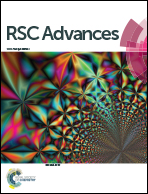Mexicanolide limonoids with in vitro neuroprotective activities from seeds of Khaya senegalensis†
Abstract
Fourteen new mexicanolide-type limonoids, khasenegasins A–N (1–14), together with three known limonoids (15–17) were isolated from the seeds of Khaya senegalensis (Desr.) A. Juss. Their structures were elucidated on the basis of NMR, HRMS and single crystal diffraction techniques. The absolute configuration of compound 1 was determined by single-crystal X-ray diffraction using mirror Cu Kα radiation. Two of the compounds (6 and 17) displayed in vitro neuroprotective activities against glutamate-induced injury in primary rat cerebellar granule neuronal cells (CGCs) at a concentration of 10 μM and 1 μM.


 Please wait while we load your content...
Please wait while we load your content...